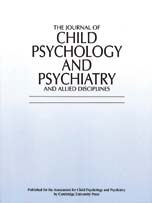The Assessment of the Situational Specificity of Children's Problem Behaviour in Peer–Peer Context
Published online by Cambridge University Press: 14 March 2001
Abstract
In both theory and research the general issue of the extent to which children's problem behaviour is generalised across situations, and to what extent it is situation specific, has been neglected. In the clinical assessment of disordered children, too, little attention has been paid to the specific situations in which these children display their inappropriate behaviour. In this study the Taxonomy of Problematic Social Situations (TOPS) (Dodge, McClaskey, & Feldman, 1985) was employed. This is a questionnaire in which the child's teacher is asked to rate the likelihood of a child responding in an inappropriate manner in a specific situation. Characteristics of TOPS were investigated both in randomly selected normal school children and in boys with a conduct disorder. Four factors appeared to underlie the TOPS scores from 652 randomly selected boys and girls from grades 1 to 6, these being: teachers' scores for the types of problem situation Being Disadvantaged, Coping with Competition, Social Expectations of Peers, and Teacher Expectations. Because of the high internal consistency of the four factors, TOPS was abbreviated to a TOPS-Short Form (18 instead of 44 items). The four-factor model was cross-validated by means of a second sample of 326 boys and girls. A model with only one general problem behaviour factor did not fit the data of both samples. When the four specific factors were added a satisfactory fit resulted. Moreover, it was found that in the first sample 52% of the variance was explained by the general factor, whereas 18% of the variance was explained by the four specific factors together. Thus, the extent to which problem behaviour is situation specific should not be disregarded. In all four types of problem situation, boys showed more inappropriate behaviour than girls. With increasing age, children were rated as being more competent in dealing with the problem situation Being Disadvantaged. Teachers rated the four types of problem situation as more problematic for boys with a conduct disorder (N = 42) than for normal control boys (N = 67). Conduct disordered boys also differed individually in the number of situational types that were problematic for them. With respect to clinical implications, the identification of the particular social context in which a conduct disordered child displays his or her inappropriate behaviour may help refine treatment goals: more adequate social functioning should be aimed at specifically in those situations that are problematic.
- Type
- Papers
- Information
- The Journal of Child Psychology and Psychiatry and Allied Disciplines , Volume 42 , Issue 3 , March 2001 , pp. 413 - 420
- Copyright
- © 2001 Association for Child Psychology and Psychiatry
- 47
- Cited by


